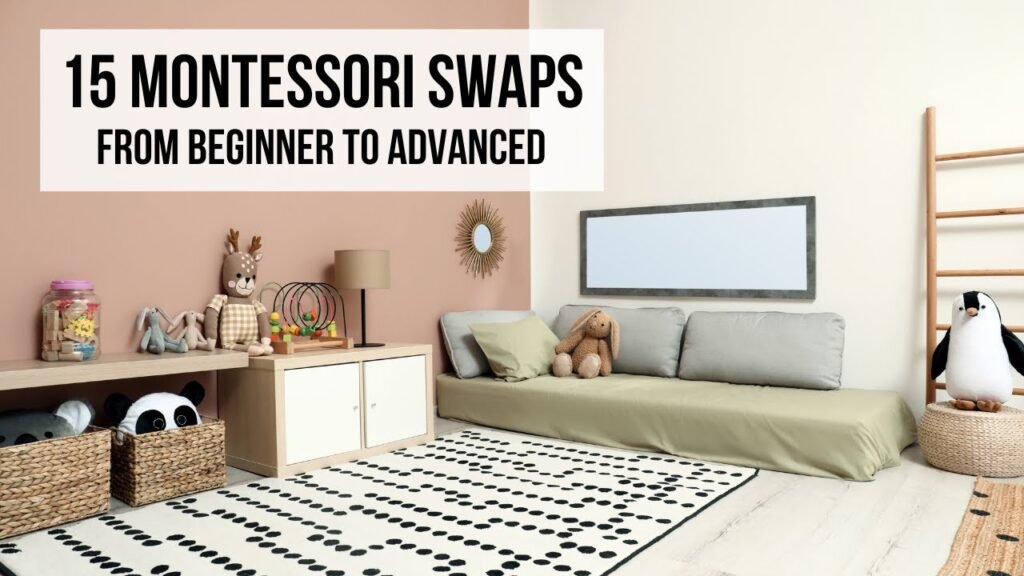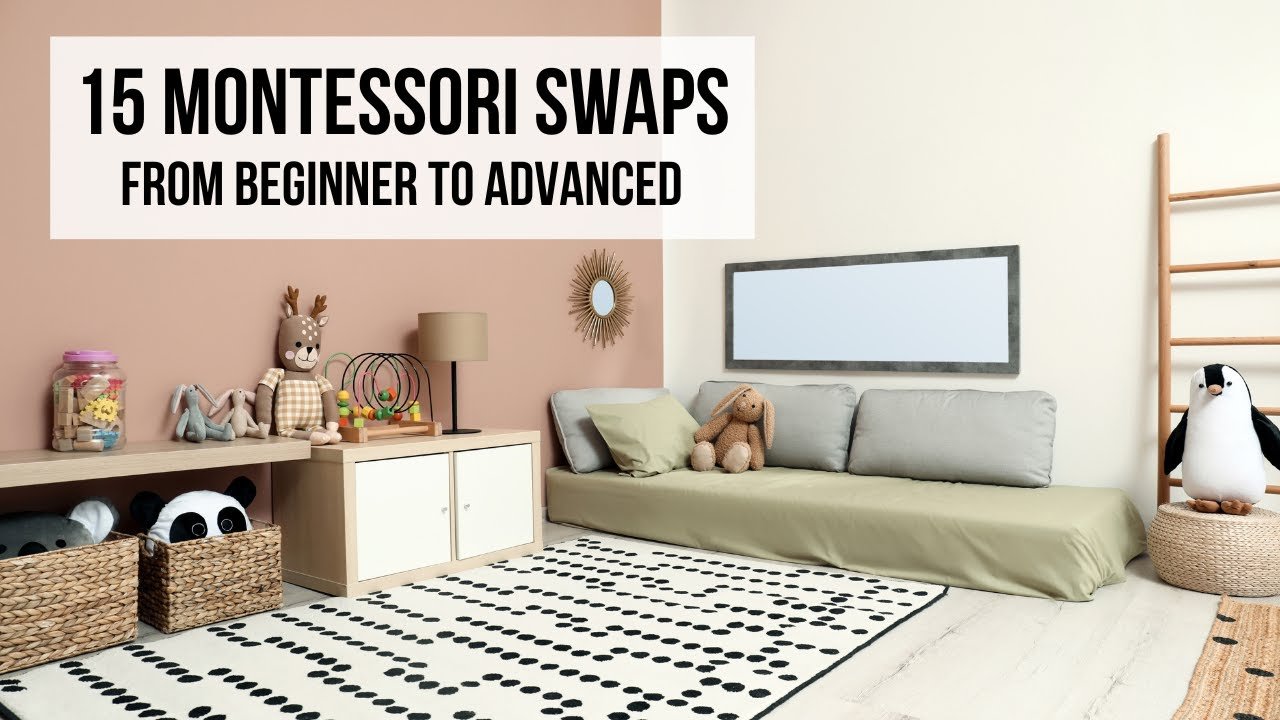In the video titled “15 Montessori Parenting Swaps from Beginner to Advanced,” Hapa Family explores various swaps that Montessori parents can incorporate into their parenting style. The video dives deep into each swap, providing in-depth explanations and demonstrations. Some of the swaps discussed include using a floor bed instead of a crib, employing weaning tables and an open glass approach to eating, and using real metal cutlery for babies. Additionally, the video touches on setting up shelves, practicing shelf rotation, creating “yes” spaces for children, promoting freedom of movement, addressing the issue with praise, and implementing positive discipline. Hapa Family also provides links to recommended reading and the audio+video gear they use, along with ways to follow them on Instagram or contact them for business inquiries. It’s important to note that the video is not intended for children and focuses on the key differences between Montessori parenting and traditional parenting, offering 15 practical swaps for Montessori parents to incorporate into their homes. The swaps are divided into two categories: physical changes in the environment and changes in how parents interact with their children. This comprehensive guide offers valuable insights, tips, and practices for Montessori parents of all levels.

Physical Environment Swaps
Swap 1: Using a floor bed instead of a crib
One of the first physical changes you can make as a Montessori parent is to use a floor bed instead of a crib for your child’s sleep. A floor bed is simply a mattress placed directly on the floor or on a bed frame low to the ground. This allows your child to have freedom of movement and promotes their independence from an early age. It also eliminates the need for crib rails and allows your child to get in and out of bed on their own. Additionally, a floor bed provides a safe and comfortable space for your child to explore and rest.
Swap 2: Offering a weaning table instead of a high chair
Instead of using a traditional high chair for your child’s meal times, consider using a weaning table. A weaning table is a small table and chair that is specifically designed for young children. The table and chair are low to the ground, allowing your child to sit comfortably with their feet flat on the floor. This promotes proper posture and allows your child to develop independence during meal times. By sitting at a weaning table, your child can learn to eat independently and become more self-sufficient.
Swap 3: Using real metal cutlery and open glass for babies
Instead of using plastic cutlery and sippy cups, consider offering your baby or young child real metal cutlery and open glass. Using metal cutlery, even with plastic handles, allows your child to effectively use a fork, spoon, and knife without frustration. Metal cutlery provides more stability and control, making it easier for your child to eat independently. Similarly, using open glasses instead of sippy cups or cups with lids and straws encourages your child to develop their drinking skills. It takes practice, but they will learn how to drink from an open cup and gradually transition to larger glasses as they grow.
Swap 4: Setting up shelves for easy access to toys and materials
Setting up shelves in your child’s environment can greatly enhance their independence and promote their learning. Instead of keeping toys and materials in closed containers or hidden away, organize them on open shelves where your child can easily see and access them. This allows your child to make independent choices and develop decision-making skills. By having a designated place for each toy or material, your child can learn to be responsible for tidying up after themselves and keeping their environment neat and organized.
Swap 5: Practicing shelf rotation to encourage exploration
To further enhance your child’s learning and exploration, consider practicing shelf rotation. Instead of leaving all toys and materials out at once, rotate them on a regular basis. This means periodically swapping items on the shelves and introducing new ones while temporarily storing others away. Shelf rotation ensures that your child always has a fresh set of toys and materials to engage with, promoting their curiosity and creativity. It also helps to prevent overwhelm and keeps their environment visually appealing.
Parent-Child Interaction Swaps
Swap 6: Creating ‘yes’ spaces for children
As a Montessori parent, it’s important to create “yes” spaces for your child. This means providing a safe and prepared environment where your child can freely explore and move around without constant redirection or restrictions. By creating a yes space, you empower your child to make choices, learn through their own experiences, and develop self-confidence. This can be achieved by childproofing certain areas of your home, removing potential hazards, and observing your child’s developmental stage and interests.
Swap 7: Promoting freedom of movement
In Montessori parenting, promoting freedom of movement is essential. This means allowing your child to move and explore their environment without unnecessary constraints. Instead of relying on baby containers like swings, bouncers, or walkers, encourage your child to move and discover their world on their own. Provide safe and open spaces where they can crawl, walk, and climb. By promoting freedom of movement, you support your child’s physical development, independence, and coordination.
Swap 8: Addressing the problem with praise
In traditional parenting, praise is often used as a form of motivation and reward. However, in Montessori parenting, we address the problem with praise. Instead of constantly praising your child for their achievements, focus on providing specific and meaningful feedback. Acknowledge their effort, process, and progress rather than simply praising the end result. This helps your child develop intrinsic motivation, self-awareness, and a growth mindset. By shifting the focus from external validation to internal satisfaction, you encourage your child to embrace challenges and learn from their mistakes.
Swap 9: Implementing positive discipline techniques
Positive discipline is a key aspect of Montessori parenting. It emphasizes teaching and guiding rather than punishing or rewarding. Instead of using punishments or time-outs, focus on redirecting and teaching appropriate behavior. Set clear and consistent boundaries, communicate expectations, and offer choices whenever possible. This approach helps your child develop self-control, empathy, and problem-solving skills. By using positive discipline techniques, you create a nurturing and respectful relationship with your child based on trust and understanding.
Swap 10: Waiting for the right moment to offer help
As a Montessori parent, it’s important to wait for the right moment to offer help to your child. Instead of rushing to assist them or solving problems for them immediately, observe and give them the chance to figure things out on their own. This promotes independence, problem-solving skills, and resilience. Of course, there will be times when your child genuinely needs your assistance, but by waiting for the right moment, you allow them to develop their capabilities and learn from their own experiences.
Promoting Independence and Resilience
Swap 11: Allowing children to experience frustration
Frustration is a natural part of learning and growth. Instead of always intervening to prevent frustration, allow your child to experience it and learn how to regulate their emotions. This doesn’t mean intentionally causing distress, but rather giving them space to work through challenges and find their own solutions. By allowing your child to experience frustration, you help them develop problem-solving skills, perseverance, and emotional resilience.
Swap 12: Encouraging autonomy in decision-making
In Montessori parenting, autonomy is highly valued. Encourage your child to make their own decisions whenever appropriate. Offer choices and allow them to consider the consequences of their decisions. This helps your child develop critical thinking skills, self-confidence, and a sense of ownership over their actions. By promoting autonomy in decision-making, you foster independence and prepare your child for future responsibilities.
Swap 13: Letting children make mistakes and learn from them
Making mistakes is an essential part of learning and growth. Instead of trying to protect your child from making mistakes, let them experience natural consequences and learn from their own actions. This doesn’t mean abandoning them or allowing dangerous situations, but rather allowing them to learn through trial and error. By letting children make mistakes and learn from them, you empower them to become independent thinkers, problem-solvers, and resilient individuals.
Swap 14: Supporting problem-solving skills
When your child faces a challenge or problem, instead of immediately providing the solution, support their problem-solving skills. Encourage them to think critically, analyze the situation, and consider possible solutions. Guide them through the process without taking over or giving the answers. This helps your child develop problem-solving strategies, persistence, and confidence in their own abilities. By supporting problem-solving skills, you foster independence and prepare your child for future challenges.
Swap 15: Cultivating a growth mindset
Promoting a growth mindset is crucial in Montessori parenting. Teach your child that abilities and intelligence can be developed through effort and practice. Encourage them to embrace challenges, learn from failures, and persist in the face of obstacles. Avoid praising intelligence or talent alone and focus on praising effort, progress, and resilience. By cultivating a growth mindset, you instill in your child a love for learning, a belief in their own potential, and a willingness to take on new challenges.
Recommended Reading and Resources
Books on Montessori parenting
There are several great books available on Montessori parenting that can provide valuable insights and guidance. Some highly recommended titles include “The Montessori Toddler” by Simone Davies, “Montessori from the Start” by Paula Polk Lillard and Lynn Lillard Jessen, and “How to Raise an Amazing Child the Montessori Way” by Tim Seldin. These books offer practical advice, tips, and explanations of Montessori principles that you can apply in your own parenting journey.
Audio+video gear used by Hapa Family
If you are interested in the audio and video gear used by Hapa Family, they provide a list of equipment that they use in their videos. This can be helpful if you are looking to improve the quality of your own videos or if you are simply curious about the equipment they use.
Following Hapa Family on Instagram
Hapa Family can be followed on Instagram, where they regularly share updates, insights, and inspiration related to Montessori parenting. Following them on Instagram allows you to stay connected and learn from their experiences and tips.
Contacting Hapa Family for business inquiries
If you have any business inquiries for Hapa Family, you can contact them via email. They provide their email address for any potential collaborations or partnerships.

